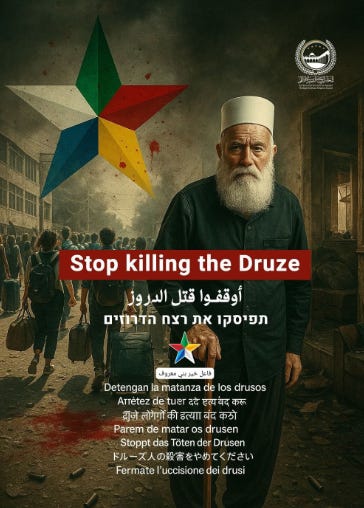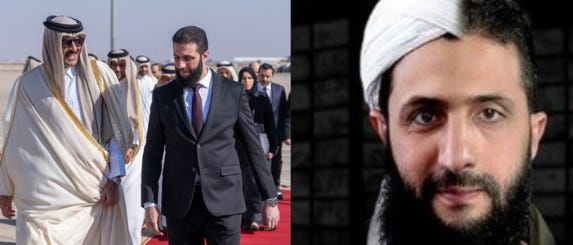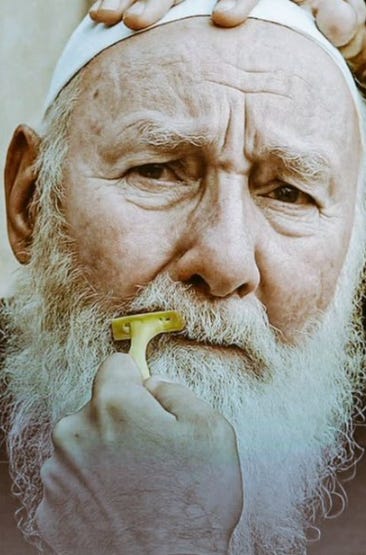The Druze “October 7th”: How Syria’s Transitional Government Enabled the Massacre
External enablers—most notably Qatari financiers and Turkish-backed proxy militias—have enabled these crimes, with their influence and funding fueling ongoing atrocities throughout the Middle East
— Warning: Descriptions of extreme violence below —
Less than a year after Bashar al-Assad’s fall, Syria’s Druze—numbering around 700,000 or 3% of the country’s population—are facing a wave of sectarian violence that chillingly echoes Hamas’s October 7th assault on Israel. The parallels are stark: coordinated beheadings, immolations, kidnappings, and public mutilations have swept from Suwayda to the outskirts of Damascus, prompting many Druze themselves to label these massacres their “October 7th.”
External enablers—most notably Qatari financiers and Turkish-backed proxy militias—have enabled these crimes, with their influence and funding fueling ongoing atrocities throughout the Middle East.
Anatomy of the 2025 Suwayda Massacre
The current wave of violence began on July 13th, 2025, when the kidnapping of a Druze trader on the Damascus road triggered tit-for-tat raids that left one abductee and three Druze shot. The situation escalated dramatically between July 13th-16th, 2025, when Bedouin militias, reinforced by Hay'at Tahrir al-Sham(HTS) border guards, stormed Suwayda city. Graphic videos circulated on social media of the atrocities, many of which were posted by the perpetrators, which left over 1100 dead.
The patterns mirror the October 7th, 2023 Hamas assault with striking precision. In both instances, armed groups driven by ideological hatred meticulously planned and carried out horrific atrocities, including beheadings, burning victims alive, mass abductions, forced suicides, dismemberment, and sexual violence targeting people of all ages. These acts, often filmed and widely circulated, aim to instill terror not only among the direct victims but also within broader minority communities. An example can be seen below from @samurai_611 on X:
Who is Behind the Massacre? The New Syrian Government
While initial violence in Suwayda province has been described as clashes between local Druze militias and Bedouin tribes, credible open-source evidence and documentation indicate a much more coordinated assault. Syrian government forces—specifically units under the Interior Ministry and new security apparatus—are directly implicated in the attacks.
Footage authenticated by rights monitors shows government-aligned fighters conducting field executions, participating in home invasions, and humiliating religious leaders by forcibly shaving their beards, an act of profound cultural and spiritual desecration for the Druze. The involvement of state actors in supporting or executing these atrocities suggests institutionalized violence against the Druze, rather than spontaneous sectarian strife.
Understanding who is orchestrating these attacks requires an examination of the factions controlling Syria’s current government. Since the collapse of the Assad regime, power in Syria has consolidated under a so-called transitional government led by President Ahmed al-Sharaa. However, the government is not unified—rather, it is a coalition of militia factions forged in Syria’s years of civil conflict.
Terrorist Factions in the Syrian Government
The most dominant faction, HTS, originated as al-Qaeda's Syrian affiliate under now President Ahmed al-Sharaa. Al-Sharaa moved from Iraq to Syria in 2011 with six men and a monthly stipend of $50,000 from Abu Bakr al-Baghdadi, the founder of ISIS, to establish al-Qaeda's Syrian branch, Jabhat al-Nusra (Now HTS). Other elements include the Syrian National Army (SNA), initially Turkish-backed opposition groups now integrated into official structures.
Senior posts across security and intelligence branches in Syria are staffed by figures with histories in extremist Islamic organizations, including both ISIS and al-Qaeda. The word "faction" here refers to these distinct armed groups, each with internal leadership and agendas, that have come under the transitional government’s broad umbrella, however many such groups participated in the atrocities.
Just as Hamas and its smaller radical Sunni factions, funded by Qatar, were behind the October 7th atrocities, the massacre against the Druze is being carried out by another coalition of radical Sunni Islamists, also funded by Qatar—one rooted in the Muslim Brotherhood and the other with ties to Al-Qaeda.

The October 7th of the Druze: Disturbing Parallels
The methodical nature of attacks against the Druze bears striking similarities to the October 7th Hamas attacks on Israeli communities. Both involved:
Systematic targeting of civilians based on religious/ethnic identity
Extreme brutality designed to terrorize beyond the immediate victims
Widespread sexual violence as a weapon
Kidnapping of victims to unknown locations
Public displays of violence and humiliation meant to dehumanize
Desecration of corpses and other acts intended to maximize psychological impact
Executions, beheadings, dismembering body parts
Live-Steaming and Posting Atrocities to Social Media
Qatar's Role: Putting Terrorists in Suits
Qatar's influence in the transition of Syria's government has been substantial and controversial. Since the beginning of the Syrian conflict in 2011, Qatar has backed opposition forces—including those in the current government. Qatar’s strategy also includes legitimizing former extremist elements through a process some critics describe as "putting a suit on a terrorist."
This approach involves rebranding militant leaders as statesmen through media campaigns, diplomatic engagement, and financial support. Qatar, a substantial backer of both Hamas and HTS, has a troubling pattern of providing financial backing to organizations with terrorist origins, then attempting to facilitate their international recognition.

Turkey’s Sponsorship of Islamists in Syria
Qatar, alongside Turkey, formed a unified bloc in supporting the same rebel groups during the Syrian conflict, including some internationally designated as terrorist organizations and the new government.
Turkey serves as another primary patron of Syria's extremist factions. Throughout Civil War, Turkey provided logistical support, safe haven, and military backing to HTS and other Islamist groups now governing Syria. President Erdogan's government facilitated foreign fighter transit, weapons transfers, and medical treatment for militants. Turkish intelligence maintains ongoing relationships with factions now accused of minority persecution, prioritizing regional influence over religious minority protection— including those who took part in the massacre.
Syria's Other Targeted Minorities
The Druze are not alone in their vulnerability. Syria’s Christians and Yazidis have also suffered forced displacement, mass abductions, and targeted killings under the new Islamist regime in Syria. Attacks on churches have resulted in dozens of deaths in Damascus and other cities.
Alawite villages have faced house-to-house massacres, beatings, and forced displacement, usually at the hands of Sunni extremist groups but, increasingly, with the complicity or participation of government-affiliated militias. Smaller groups such as Kurds and Armenians have experienced continuing displacement and property expropriation as new alliances are forged and old community boundaries dissolve.

A Cycle of Religious Violence Continues
The reality emerging from recent events in Suwayda is bleak. The atrocities against the Druze reveal not only the persistence of sectarian violence but also the complicity and direct involvement of a state apparatus frequently celebrated abroad as a force for stability. The so-called rehabilitation of Syria’s leaders—backed especially by states like Qatar and Turkey—does little to address the deep-rooted links to terrorism and factional violence that endanger every vulnerable group.
For the Druze, as for other Syrian minorities such as Christians, Alawites, and Yazidis, the current wave of violence is not simply a repeat of history but a new catastrophe. It is a sectarian disaster on the scale of October 7th, fueled by many of the same ideological animosities, and it threatens with impunity as long as armed factions, both within and outside official structures, are granted free rein to pursue their deadly agenda.




I spent time with Druze people in both eastern and western Galilee years ago. One experience was the honor to be welcomed at a Druze wedding. The groom had been in the army with our kibbutz friend. He asked if his American friends might attend and they warmly said yes. In the other situation, Druze IDF commandos who lived in a nearby village were official security for our smaller second kibbutz as near to the danger of western Lebanon as you can get. One of my jobs was to serve them lunch in the quiet hour after kibbutzniks ate and returned to the fields. In both instances my time with the Druze of Israel is precious. Druze faith requires loyalty to the nation in which they live. That, however, is intended to be mutual. Syrian Druze now have little reason to love Syria and hasn’t for a long time. Druze in eastern Israel and western Syria (and Golan) are very much cousins. There is a second loyalty to each other. Thus Israel has a role due to its mutual loyalty to and love for the Druze. shalom / salaam
Coverage of the Suwayda conflict has also been incredibly one sided when in all three: AlHajri the Bedouin and Sharra forces have committed pure evil
Love for resources on Telegram. Let nobody escape accountability